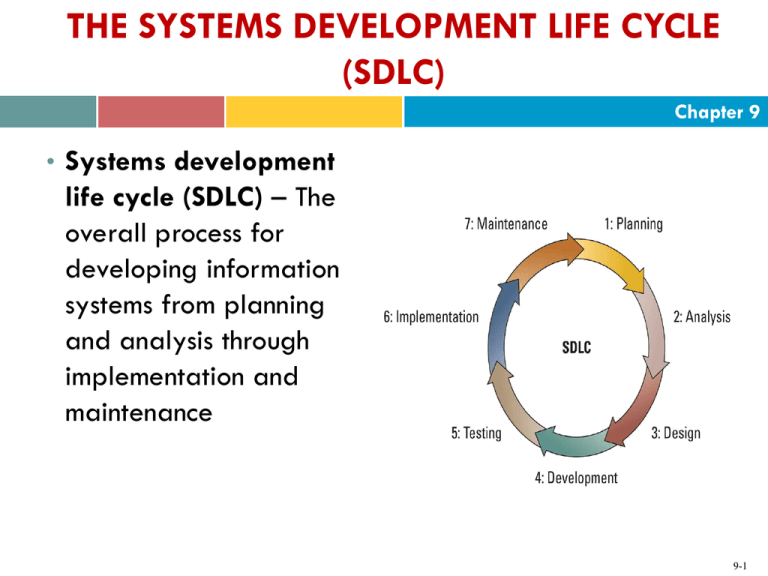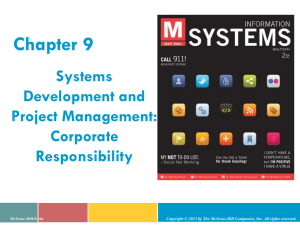More in Systems Development
advertisement

THE SYSTEMS DEVELOPMENT LIFE CYCLE (SDLC) Chapter 9 • Systems development life cycle (SDLC) – The overall process for developing information systems from planning and analysis through implementation and maintenance 9-1 SOFTWARE DEVELOPMENT METHODOLOGIES Chapter 9 There are a number of different software development methodologies including • Waterfall Agile Rapid application development (RAD) Extreme programming Rational unified process (RUP) Scrum 9-2 Waterfall Methodology Chapter 9 • Waterfall methodology – A sequence of phases in which the output of each phase becomes the input for the next 9-3 Agile Methodology Chapter 9 Iterative development – Consists of a series of tiny projects • Agile methodology – Aims for customer satisfaction through early and continuous delivery of useful software components developed by an iterative process using the bare minimum requirements 9-4 Rapid Application Development Methodology (RAD) Chapter 9 • Rapid application development methodology– Emphasizes extensive user involvement in the rapid and evolutionary construction of working prototypes of a system to accelerate the systems development process Prototype – A smaller-scale representation or working model of the users’ requirements or a proposed design for an information system • The prototype is an essential part of the analysis phase when using a RAD methodology 9-5 Extreme Programming Methodology Chapter 9 • Extreme programming (XP) methodology – Breaks a project into tiny phases, and developers cannot continue on to the next phase until the first phase is complete 9-6 Rational Unified Process (RUP) Methodology Chapter 9 • Rational unified process (RUP) – Provides a framework for breaking down the development of software into four gates Gate one: inception Gate two: elaboration Gate three: construction Gate four: transition 9-7 SCRUM Methodology Chapter 9 • Scrum – Uses small teams to produce small pieces of deliverable software using sprints, or 30-day intervals, to achieve an appointed goal • Under this methodology, each day ends or begins with a stand-up meeting to monitor and control the development effort 9-8 DEVELOPING SUCCESSFUL SOFTWARE Chapter 9 Primary reasons for project failure • Unclear or missing business requirements Skipping SDLC phases Failure to manage project scope o Scope creep o Feature creep Failure to manage project plan Changing technology 9-9 DEVELOPING SUCCESSFUL SOFTWARE Chapter 9 • The later in the SDLC an error is found the more expensive it is to fix! 9-10 MANAGING SOFTWARE DEVELOPMENT PROJECTS Chapter 9 • Analysts predict investment in MIS projects worldwide is more than $1 trillion • 70 percent will be lost due to failed projects • The consequences of failed projects include Damaged brand Lost goodwill Dissolution of partnerships Lost investment opportunities Low morale 9-11 MANAGING SOFTWARE DEVELOPMENT PROJECTS Chapter 9 • Project deliverable – Any measurable, tangible, verifiable outcome, result, or item that is produced to complete a project or part of a project • Project milestone – Represents key dates when a certain group of activities must be performed • Project management office (PMO) – An internal department that oversees all organizational projects 9-12 The Triple Constraint Chapter 9 Project Management Interdependent Variables 9-13 The Triple Constraint Chapter 9 • Benjamin Franklin’s timeless advice - by failing to prepare, you prepare to fail - applies to software development projects • The Hackett Group analyzed 2,000 companies and discovered 3 in 10 major IT projects fail 21 percent of the companies state that they cannot adjust rapidly to market changes 1 in 4 validates a business case for IT projects after completion 9-14 Project Participants Chapter 9 Project Management Role 9-15 UNDERSTANDING PROJECT PLANNING Chapter 9 • SMART criteria are useful reminders on how to ensure that the project has created understandable and measurable objectives 9-16 UNDERSTANDING PROJECT PLANNING Chapter 9 Two primary diagrams used in project planning include PERT and Gantt charts • PERT chart o Dependency o Critical path Gantt chart 9-17 UNDERSTANDING PROJECT PLANNING Chapter 9 PERT Chart EXPERT – PERT Chart Example 9-18 UNDERSTANDING PROJECT PLANNING Chapter 9 MS Project – Gantt Chart Example 9-19 MANAGING PROJECTS Chapter 9 • Managing a project includes Identifying requirements Establishing clear and achievable objectives. Balancing the competing demands of quality, scope, time, and cost Adapting the specifications, plans, and approach to the different concerns and expectations of the various stakeholders 9-20 OUTSOURCING PROJECTS Chapter 9 • In-sourcing (in-house-development) – Uses the professional expertise within an organization to develop and maintain its information technology systems • Outsourcing – An arrangement by which one organization provides a service or services for another organization that chooses not to perform them in-house 9-21 OUTSOURCING PROJECTS Chapter 9 • Factors driving outsourcing growth include Core competencies Financial savings Rapid growth The Internet and globalization 9-22 OUTSOURCING PROJECTS Chapter 9 • Onshore outsourcing • Nearshore outsourcing • Offshore outsourcing 9-23 OUTSOURCING PROJECTS Chapter 9 • Most organizations outsource their noncore business functions, such as payroll and IT 9-24






